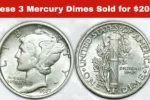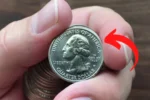The Rare Lincoln Wheat Pennies Worth $11 Million: The Lincoln Wheat Penny is one of the most iconic coins in U.S. history, cherished by collectors and history enthusiasts alike. These small yet significant coins have witnessed major historical events and, in some cases, have become incredibly valuable over time.
Some rare Lincoln Wheat Pennies are still circulating today, making the hunt for these hidden treasures all the more exciting. In this article, we’ll explore some of the most fascinating and valuable Lincoln Wheat Pennies that every collector should know about.
1. The 1935 Lincoln Wheat Penny – A Piece of Great Depression History
At first glance, a 1935 Lincoln Wheat Penny in poor condition might not seem like much. However, this coin carries significant historical weight, as it was minted during the throes of the Great Depression a time when every cent truly mattered to Americans.
With a mintage of over 245 million at the Philadelphia Mint, the 1935 Wheat Penny was widely circulated. Designed by Victor David Brenner, the obverse of the coin features a portrait of Abraham Lincoln, accompanied by the inscriptions “In God We Trust,” “Liberty,” and the date “1935.” On the reverse, the classic wheat ears flank the denomination, along with the Latin motto “E Pluribus Unum.”
Despite its relatively high mintage, the 1935 Wheat Penny remains a sought-after collectible. Even in poor condition, these coins serve as a tangible link to an era when Americans relied on every penny for necessities like food and savings. While a heavily worn 1935 Wheat Penny may not be worth much in terms of monetary value, its historical significance makes it a cherished item among collectors.
2. The 1949 Lincoln Wheat Penny – A Minting Error Worth Collecting
The post-World War II era brought renewed optimism to the United States, and the 1949 Lincoln Wheat Penny was part of that period’s everyday transactions. While this coin may seem common, one particular variety stands out: the 1949 clipped planchet error.
A clipped planchet error occurs when a coin blank is improperly punched out of a metal sheet, resulting in a missing crescent-shaped or straight-edged section.
These errors are rare, as most flawed coins are caught during quality control. However, some slipped through, making them valuable to collectors.
The value of a 1949 clipped planchet Wheat Penny depends on the size and location of the clip, the overall condition of the coin, and whether additional minting errors are present.
Minor clips may be worth $20 to $50, while more dramatic examples can fetch several hundred dollars. Coins with additional errors, such as die cracks or doubling, can be even more valuable.
3. The 1952 Lincoln Wheat Penny – The Appeal of Brown Patina
By 1952, the Lincoln Wheat Penny had been in circulation for over four decades. This coin, minted in large quantities, is not necessarily rare. However, some 1952 Wheat Pennies have developed a unique brown patina due to environmental factors like oxidation, heat, and chemical exposure.
Most Wheat Pennies were struck using a 95% copper composition, which reacts over time, resulting in shades ranging from reddish-brown to deep chocolate tones. Collectors prize well-preserved coins with attractive, natural patinas, as they add character and uniqueness.
The 1952 Wheat Penny was produced at three U.S. Mints:
- Philadelphia: Over 186 million minted
- Denver: Approximately 746 million minted
- San Francisco: About 137 million minted
While common in circulated condition, uncirculated examples with exceptional toning or minimal wear can command higher prices. Coins in mint-state condition (MS65 or higher) can be valued between $15 and $50, depending on the quality and aesthetic appeal.
4. The 1925 Lincoln Wheat Penny – A Scarce Find in Fine Condition
The 1925 Lincoln Wheat Penny hails from the Roaring Twenties, a time of economic prosperity and cultural shifts. This coin is particularly valuable when found in fine or better condition, as many pennies from this era were heavily circulated and show significant wear.
Designed by Victor David Brenner, the 1925 Wheat Penny features Lincoln’s right-facing portrait on the obverse, with inscriptions for “In God We Trust,” “Liberty,” and the year. The reverse showcases the traditional wheat ears flanking “One Cent” and “E Pluribus Unum.”
Mintage figures for the 1925 Wheat Penny are as follows:
- Philadelphia Mint (no mint mark): 139,900,000 minted
- Denver Mint (“D” mint mark): 22,580,000 minted
- San Francisco Mint (“S” mint mark): 26,380,000 minted
Despite these high mintage numbers, finding a well-preserved 1925 Wheat Penny can be challenging. A fine-condition coin from Philadelphia typically sells for $0.50 to $1, while rarer Denver and San Francisco variations can fetch between $1.50 and $3 or more. Uncirculated specimens, particularly those with vibrant luster, can exceed $50 in value.
5. The 1924 Lincoln Wheat Penny – A Legacy of the Roaring Twenties
The 1924 Lincoln Wheat Penny was minted at a time when the United States was experiencing rapid industrialization, cultural change, and economic growth. Designed to commemorate the 100th anniversary of Abraham Lincoln’s birth, this coin is a symbol of both historical and numismatic significance.
Like other Wheat Pennies, the obverse features Lincoln’s portrait with the standard inscriptions, while the reverse displays the wheat ears and denomination. What makes some 1924 Wheat Pennies special is their natural brown patina, which enhances their appeal among collectors.
Mintage figures for the 1924 Wheat Penny include:
- Philadelphia Mint (no mint mark): 75,787,000 minted
- Denver Mint (“D” mint mark): 2,520,000 minted
- San Francisco Mint (“S” mint mark): 11,696,000 minted
The Denver and San Francisco mint variations are considerably rarer than the Philadelphia issue, making them more desirable to collectors. A fine-condition 1924 Denver Wheat Penny can be worth $15 to $30, while pristine uncirculated specimens may reach $100 or more.
Conclusion – Keep an Eye on Your Pocket Change!
While many Lincoln Wheat Pennies remain in circulation, some rare varieties hold significant value. Whether you’re a seasoned collector or just starting, searching for these historical treasures can be both rewarding and educational.
Next time you come across an old penny, take a closer look you might just have a valuable piece of American history in your hands!













